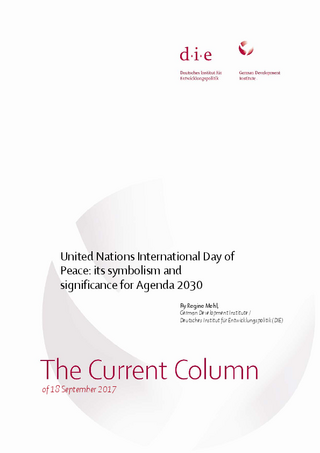United Nations International Day of Peace: its symbolism and significance for Agenda 2030
Mehl, RegineThe Current Column (2017)
Bonn: German Development Institute / Deutsches Institut für Entwicklungspolitik (DIE) (The Current Column of 18 September 2017)
Bonn, 18 September 2017. Hand on heart: who knows that the United Nations International Day of Peace is celebrated on 21 September? It is also important in this context and on this special day to make reference to Agenda 2030, which makes some challenging key points with regard to the issue of peace. 21 September 1981: symbolism without consequence In 1981, the UN General Assembly, decided to celebrate the International Day of Peace on this date. Behind the symbolism of the International Day of Peace is the eternal longing for peace. But what role does this day actually play? The fact of the matter is that the number of wars and violent conflicts and the level of their brutality has remained at a consistently high level since the end of the Second World War. As such, it is no wonder that the International Day of Peace barely figures in the collective memory of global events if at all. It appears to be a symbolic gesture of resignation to the power of fact. 25 September 2015: conditions for lasting peace in Agenda 2030 In contrast to this, Sustainable Development Goal (SDG) 16 of Agenda 2030 no longer formulates a “longing for peace”, but rather hammers out challenging key points, which ultimately serve as reference points for all 17 SDGs: “Promote peaceful and inclusive societies for sustainable development, provide access to justice for all and build effective, accountable and inclusive institutions at all levels” (SDG 16). In conjunction with the Universal Declaration of Human Rights, which forms the umbrella for Agenda 2030 in the resolution, this single sentence is essentially being assigned the classic framework of democratic statehood as a prerequisite for peace / peaceful and non-violent co-existence. Without these fundamental coordinates, it would counteract implementation work in the national and regional forums and at the various global levels for all other SDGs. Peace in 16th place: substantively plausible? Given the limited practical impact of peace endeavours in recent decades, you might think that “lowly” 16th place among the SDGs would be sufficient for peace and the rule of law, stable institutions and good governance, and that this would also explain why peace only occupies fourth place among the “five Ps” in the Preamble to Agenda 2030. However, another interpretation is at least equally justified. According to this interpretation, 16th place is the logical position for peace in a highly complex chain of causes and effects which can be derived primarily from the Preamble to Agenda 2030. The logic is as follows: (a) only when poverty and hunger have been eradicated around the world; (b) only when natural resources have been safeguarded on a sustainable basis and climate change has been stopped; (c) only when people can live lives characterised by prosperity and sustainable consumption and economic, social and technical progress has been brought into harmony with the natural world – only then can (d) peace frameworks be developed and, most of all, placed on a sustainable footing. Peace: on the way to first place? If we are to adopt an expedient approach and take this cause and effect logic seriously, not least in view of the time pressure involved (there are only 13 years left until 2030), then it is advisable to read very closely the final paragraph of the preamble, which explicitly calls for interlinkages to be made between the SDGs of Agenda 2030. Consequently, it is recommendable to adopt a two-level strategy for negotiations on global and regional committees: Level 1: Interlink material levels which are mutually definitional with regard to SDG 16. For example, Target 16.4 “Illicit financial and arms flows” must be meaningfully integrated and negotiated with SDG 8 (“Sustainable economic growth”) and SDG 17 (implementation: technology as capital). Armament technology is one of the least sustainable technologies of all – it virtually counteracts sustainable development and is either presented unused as a threat or used to kill. Level 2: Bring the complex dimensions of the human rights addressed in many of the SDGs as closely together as possible with the material levels. For example, the development and fostering of an ethic of global citizenship advocated under item 36 of the Introduction to Agenda 2030 must be measured against the implementation of targets 16.A and 16.B (anti-terrorism and non-discrimination). Things could hardly be more complex, as this sets out the ambition of attaching a global ethos of tolerance, trade-offs and, by extension, peaceful ethics and morality to the virtually indescribable diversity of life at global level. Such an ambition barely stands up to a reality check. In order to provide a firm foundation for the peace target, the partnerships between the SDGs explicitly called for in the Agenda need to be addressed. Just as in the case of the climate SDG, this will prove to be a colossal challenge. However, in the absence of all symbolism, the United Nations International Day of Peace would finally earn the right to become a truly popular day.

